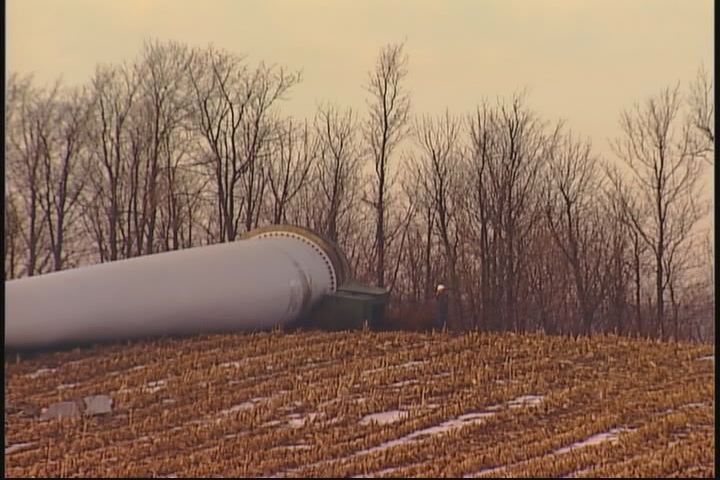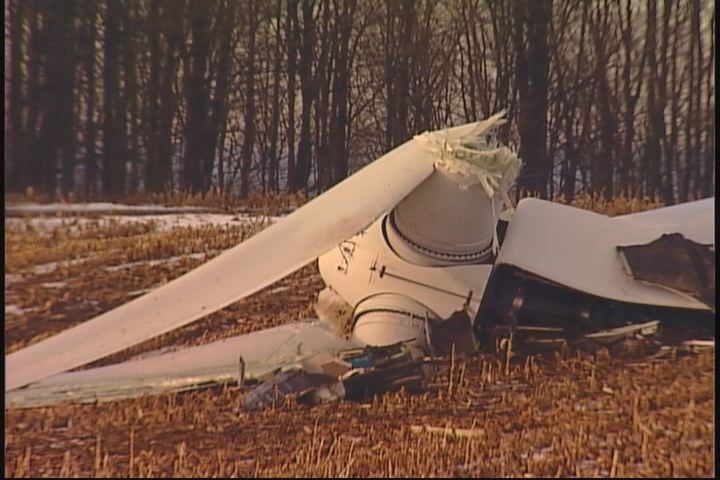Entries in wind developer contract (11)
1/22/10 Why are our neighbors to the north making noise about turbine noise? And Beavers best Badgers when it comes protecting communities from wind turbine noise limits
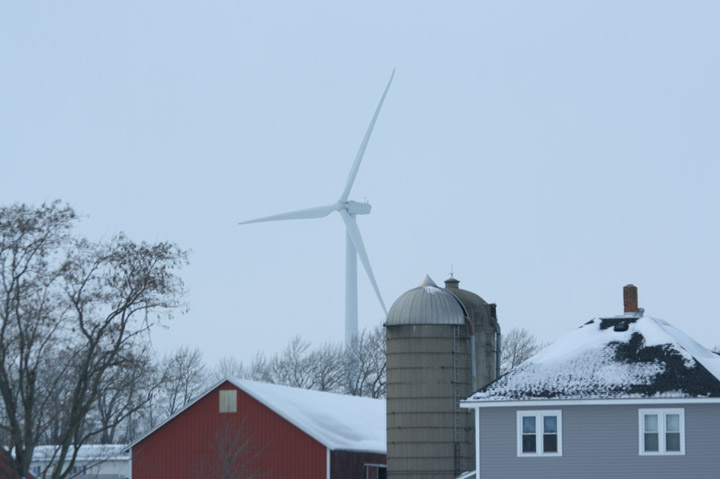
Home in a wind farm. Fond du Lac County, Wisconsin. Photo by Gerry Meyer 2009
Government of Ontario requests 'Expert Advice' on Wind Turbine Noise
From THE SOCIETY FOR WIND VIGILANCE
January 20, 2010
TORONTO- The government of Ontario admitted this week that it does not know 'how or whether' to measure for low frequency sound at wind turbine installations.
Two Requests for Proposal www.merx.com were issued yesterday by the Ontario Ministry of Environment to help the ministry in "determining how or whether to regulate low frequency noise emissions from wind turbines".
The requests go on to state, "The Ministry requires a consultant to assist in the development of ameasurement procedure to assess noise compliance of existing wind farms with the applicable sound level limits"
"Unlike typical industrial noise sources, measurement of audible noise from wind turbines in general raises technical challenges."
The request adds, "the MOE Noise Guidelines for Wind Farms, October 2008 do not contain a measurement method for assessing the actual noise impact."
Questions arise:
If the government does not have a method for measuring noise impact, why are they moving ahead with more wind developments before proper studies and science are completed?
How did the Ministry of Environment arrive at an arbitrary distance of 550m from industrial wind turbines to protect from noise?
Reports of adverse health effects experienced by people living too close to industrial wind turbines have been brought to the attention of the Ministry of Environment for more than two years.
Nothing has been done to mitigate the suffering and many have been forced to abandon their homes or be bought out by a wind developer. Hundreds of requests for mitigation of the issue have not been dealt with yet industrial wind turbines continue to be erected.
The Society for Wind Vigilance, an International Federation of Physicians and other professionals, repeats its appeal to all governments including the Government of Ontario to place a moratorium on all wind development until a third party health study is conducted into the impact of industrial wind turbines on human health.
At the minimum, current turbines should be turned off at night as a French court ruled and new industrial wind turbines should be set back a minimum of 2000 meters from residences. Ongoing monitoring for adverse health effects must be conducted.
SECOND FEATURE:
Note from the BPWI Research nerd: The Oregon State noise limit for the Invenergy wind farm mentioned in the following story is 36 dbA
The current turbine noise limit for Invenergy in the State of Wisconsin is 50 dbA
The "too loud" referred to in the story below is under 38dbA
Study says wind farm is too loud
East Oregonian, eastoregonian.com
January 21, 2010
The Willow Creek Energy Center is in violation of state noise standards for at least three nearby homes, its acoustical expert revealed at a planning commission meeting Tuesday night. Still up for debate, according to the other experts in attendance, is how much and how often.
The meeting amounted to a day in court for the neighbors of the wind farm – Dan Williams, Mike and Sherry Eaton and Dennis Wade – who began complaining about farm’s noise and other effects last year.
According to Oregon Administrative Rule, energy-generating facilities can be as loud as 36 decibels at adjacent homes – that’s 26 decibels for background noise plus 10 for the facility. In the analysis of the acoustical expert that Invenergy hired, Michael Theriault of Portland, Maine, the noise at the Wade residence was usually less than 36 decibels. At the Eaton residence, it was usually less than 37 decibels. At the Williams residence, the noise “moderately” exceeded the noise code about 10 percent of the time, Theriault said.
Theriault also conducted a noise study at the home of another neighbor, Dave Mingo, and found that the noise was usually less than 37 decibels. “On overview, the facility is substantially in compliance with state rules,” he said.
Kelly Hossainin – a lawyer for Invenergy, the company that runs Willow Creek Energy Center – argued that the amount by which the wind farm exceeded the noise limit at the Eaton and Mingo residences, one decibel, is not perceptible outside a laboratory environment.
She said the times the wind farm exceeded the noise standards were unusual events, which would qualify for an exception under the rules.
Theriault explained some of his methods to the planning commission. For example, he did not analyze the noise data that was generated while the wind was blowing more than 9 meters per second (about 18 miles per hour). According to General Electric, the company that made the turbines, turbine noise does not increase after that point, he said.
Commissioner Pam Docken asked Theriault if he could speak to the health effects of turbine noise.
“Annoyance is a very complex phenomena,” he said, referring to a recent wind-industry study that found no negative health effects of wind turbines except annoyance. “We know that in some cases, annoyance isn’t even related to noise level. It can be related to whether they see the noise source and can change with the subject’s attitude to the noise source.”
Then Kerrie Standlee, a prominent acoustical expert – he works for the Oregon Department of Energy doing site certification reviews and was even hired by Morrow County to analyze the racetrack issue – began to speak for the Eatons, Williams and Wade. He presented his own noise study, which showed that the noise at the Eaton’s residence hovered just above the noise standard on a regular basis, and at the Williams residence it regularly went above 40 decibels.
Standlee also analyzed Theriault’s study. He pointed out that the wind farm consistently broke the noise rule at precisely the time when Theriault decided not to use the data – when wind speeds exceeded 9 meters per second.
When the data is analyzed in a wider range of wind speeds, he said, the wind farm was in violation of the rule 22 out of 37 nights.
“I’m not sure how someone can say this is an unusual, infrequent event,” he said. “To me, 59 percent is not occasional or unusual.”
Standlee’s noise study also went beyond Theriault’s in that he gave the residents a sheet of paper to log their experiences with time and date. He then overlaid those comments on the data and showed that when the residents reported high noise, the wind was blowing from a particular direction or at a particular speed.
Another acoustical expert, Jerry Lilly, spoke for Dave Mingo. He came up with results similar to Standlee’s, but noted that the Theriault study was also flawed because it did not measure noise at the residence’s property line – as required by Morrow County noise ordinance – and it did not measure the noise inside the homes.
The commission also heard heartfelt testimony from the residents themselves, who said that their lives had been completely changed since the wind farm came.
“A basic right in my life is to live in my beautiful home with my peace and quiet, and now I can’t do that,” Dan Williams said.
When the testimony ended, the planning commission agreed to wait until their next meeting to make a decision about whether – and how – the Willow Creek wind farm must mitigate the noise problem.
1/22/10 Dear Columbia County, Did you know those 90 Glacier Hills turbines come with an automatic extra 18 turbine 'Country Cousin'?
 PSC STILL SORTING OUT DETAILS OF COLUMBIA COUNTY WIND FARM
PSC STILL SORTING OUT DETAILS OF COLUMBIA COUNTY WIND FARM
By Lyn Jerde, Daily Register, portagedailyregister.com
January 21 2010
Within days, the Public Service Commission of Wisconsin will finalize its list of conditions for the construction of a wind farm in northeast Columbia County.
But officials of We Energies already are planning where the turbines will go and determining whether the PSC’s conditions will allow erecting all 90 of them.
On Jan. 11, the PSC approved a certificate of public convenience and necessity for the wind farm, called Glacier Hills Wind Park, on about 17,300 acres of farmland in the towns of Scott and Randolph.
The proposal called for 90 turbines, each about 400 feet tall, capable of generating up to 207 megawatts of electricity.
The commission met again Wednesday, this time to draft the specifics of conditions that the commissioners had discussed Jan. 11 before granting approval for the project.
PSC spokeswoman Teresa Smith said Monday is the deadline for the formal list of conditions to be in the hands of We officials. The list is undergoing final editing, based on the discussion of the commission at its meeting in Madison on Wednesday.
We Energies spokesman Brian Manthey said he listened to the live electronic broadcast of Wednesday’s meeting and has heard nothing in the proposed conditions that could stall or stop the utility’s plans to start construction late this spring.
The most challenging condition, however, is a minimum 1,250-foot setback between each turbine and the property of landowners who are not leasing any land for the turbines, Manthey said.
The original proposal, with 90 preferred turbine sites and 28 alternate sites, included a minimum setback of 1,000 feet from nonparticipating landowners, he said.
The hope, he added, is that “preferred sites” that are closer than 1,250 feet can be replaced with alternate sites that meet the setback requirement, thus allowing all 90 turbines to be built. It’s too early, however, to determine whether the setback rules will result in fewer turbines going up, he said.
“Hopefully, we’ll be up to that number of 90,” he said, “but it might be a different 90 than we’d planned.”
The PSC’s condition limiting the noise of the turbines also is a factor, Manthey said – not only in where they are located, but also in the type of turbines eventually used in Glacier Hills.
The commissioners set noise limits of 50 decibels day and night during colder months and 50 decibels by day and 45 decibels by night during the warmer months when people often like to sleep with their windows open.
Minimizing noise is one reason why We Energies is considering turbines capable of generating 1.8 megawatts each, for a total of 162 megawatts. Manthey noted that these turbines would be about as tall as the ones that would, all together, generate the 207-megawatt maximum allowed by the PSC. The difference in the turbines, which accounts for the difference in the noise they create, is the size of the attached generators.
No final decision has been made regarding the generation capacity of the turbines that soon will be part of Columbia County’s skyline.
But even if the project were to generate the maximum power allowed, Manthey said, We Energies still would need other renewable energy projects to meet the state requirement of generating 10 percent of its electricity from renewable resources by 2015. (Those standards might go up. There’s legislation pending in Wisconsin to raise the renewable energy standards for utilities to 20 percent by 2020 and 25 percent by 2025.)
We Energies has another renewable project pending – a power plant built on the premises of a paper mill near Rothschild, south of Wausau, that would burn waste wood left over from the paper-making process.
Meanwhile, Manthey said, it’s not certain when Columbia County residents can look for trucks carrying the huge wind turbine components down the country roads. The initial construction work will entail site preparation and foundation building. Glacier Hills is expected to be up and running by late 2011.
NOTE FROM THE BPWI RESEARCH NERD: According to following press release, the 90 turbine Glacier Hills wind farm mentioned above has an 18 turbine "country cousin."
New 30-Megawatt Wind Project in Columbia County Approved
PRESS RELEASE: E Wind LLC last week received approval to proceed with its 30-megawatt, 18-turbine wind project near Friesland, Wisconsin and the recently approved Glacier Hills wind project to be built and owned by WE Energies.
E Wind LLC is the country cousin to the larger Glacier Hills project, being developed by some local landowners and entrepreneurs who are determined to not let all renewable energy (and money) go to the big companies. Bob Lange, an E Wind member who farms near Columbus remarked, "I was involved in the development of the UWGP ethanol plant in Friesland and saw all these wind measurement towers being installed in the area by several large wind developers; that got me thinking that wind energy might be the next renewable energy of choice for the area." Bob found a few others to join him and off they set to put together a wind project. It included finding willing landowners to lease their property for turbines, paying the transmission owners to study the electrical connection of their project, installing a 200-foot tall wind measurement tower, and approaching the Town of Randolph about receiving permission to build the project.
Wes Slaymaker, P.E., of WES Engineering LLC, a Madison-based wind energy consulting company who is acting as the E Wind LLC project engineer, commented, "We staked some possible turbine locations in the winter of 2008 and spent the next year moving those locations around to address all the concerns of the landowners and community members." Later E Wind hired Cullen Weston Pines and Bach LLP, a Madison law firm, to assist the project with negotiating a development agreement with the Town of Randolph.
Unfortunately, E Wind’s timing was poor as the Glacier Hills project had recently been announced by We Energies and the local area was inflamed with concerns regarding how that large wind project would affect their homes and communities. The E Wind members spent plenty of their evenings attending town and village meetings. They hoped to get some sympathy from the area residents as the local project and eventually convinced the town to vote to approve the E Wind project, contingent upon the approval of the larger Glacier Hills project.
1/20/10: University of Iowa: Important advice on leasing your land to a wind developer
Thinking of leasing your land to a wind developer?
The University of Iowa helps you read the fine print--
SOURCE: "Wind Energy Production: Legal Issues and Related Liability Concerns for Landowners in Iowa and Across the Nation"
University of Iowa, Center for Agricultural Taxation, November 2009
Click here to download entire document.
Legal Issues for Landowners to Consider in Negotiating Wind Energy Easements
A wind energy agreement should never be negotiated without first having the agreement reviewed by legal counsel.
Wind energy agreements are long-term agreements that will impact the land subject to the agreement for many years, likely beyond the lifetime of the landowner who executes the agreement.
The following is a list of questions that landowners should ask when analyzing any wind energy agreement:
Scope Questions:
• How much of the land will be subject to the agreement?
Note: The legal description of the covered property is critical.
• How long will the land subject to the agreement be affected?
• Based on the property rights that are given up, are the proposed payments adequate for the present time and for the life of the agreement?
(Note: The answer to this question requires an understanding of the mechanics and economics of wind energy production.)
Estate Planning Issues
• Is it planned that the farming operation will expand in the future?
If so, how will the placement of wind turbines on the property impact the farm’s potential development
and/or expansion?
• Has the issue of wind turbines development been discussed with the on-farm heirs?
Payment Questions:
• Is the landowner entitled to any or all energy credits related to the project?
• If the agreement offers an up-front lumpsum payment, is the payment representative of a fair amount of the rights involved?
• What are the tax consequences of wind energy payments that will be paid under the agreement?
(Note: The answer to this question depends on tax changes at the federal and state levels – an area which is in an almost constant state of flux.)
• Are payments under the agreement based on revenues generated by the wind turbines? Can the landowner get information as to how the owner’s revenue will be calculated?
• If the wind energy company puts additional equipment on the towers and collects compensation for such placement is the landowner entitled to some of the additional compensation?
• Does the agreement guarantee that a set number of wind energy turbines will be constructed on the land by a specific date and, if not, is the developer willing to guarantee a minimum amount of payments?
What are the developer’s rights?
• Does the developer want to develop the land or simply use a portion of the surface for a term of years?
• Is the developer able to sell or transfer without the landowner’s consent any of the land use rights obtained under the agreement? If so, will the original developer remain liable if the new developer or holder of the easement right does not pay the landowner or otherwise defaults?
• What events trigger the developer’s right to terminate the contract? Can the developer terminate the contract at any time without cause? If so, how are payments due under the agreement to be handled?
Cost Questions:
• Will any portions of the property require gating, fencing or limiting of access in any manner? If so, who pays for the cost or building and/or repairing such measures for restricting access?
• Is there any potential for environmental contamination or the release of hazardous materials onto the premises because of the presence of wind turbines on the property?
If so, how are associated costs to be borne?
• Are any additional costs associated with compliance with governmental regulations of wind turbines, present and in the future, the responsibility of the landowner, developer or wind energy company?
• What is the cost of the landowner becoming an additional insured on the insurance policy of the wind energy company?
• Are there any potential costs of construction liens that might be placed on the property?
• If the agreement limits the ability of the landowner to expand the farm or make improvements (such as installing irrigation equipment, field tile, or additional structures), what are the economic costs to
the overall operation of such limitations?
• The development of the property will require the construction of roads. Does the agreement provide compensation for any damage to existing drainage tile and/or additional costs associated with the change
in the flow of surface water that could negatively impact adjacent property?
• If the development of the property with wind turbines increases the ad valorem real property valuation of the property, must the landowner pay the additional taxes?
• If an adjacent landowner files a lawsuit against the landowner based on nuisance or other tort theories, will the wind energy company pay the landowner's legal costs and any resulting judgment rendered against the landowner directly tied to the presence of the wind turbines?
• When the agreement ends or is otherwise terminated, does the landowner bear the cost of removing wind energy structures? What are the landowner’s rights?
• What termination rights does the landowner have? How does the landowner exercise those rights?
Note: Wind energy agreements often contain termination clauses designed to minimize the risk of termination to the developer so as to aid the developer in receiving financing. Accordingly, wind energy agreements typically prevent a landowner from terminating (or taking action against the wind energy company) an agreement due to noise, flicker, vibrations, air turbulence, electromagnetic interference with global positioning systems, and other effects caused by the wind turbines.
• If the agreement is terminated, whether by consent of the parties or otherwise, what happens to the wind energy structures and located facilities erected on the property?
What is the developer required to remove? How soon must structures be removed? Who pays for their removal?
Crafting an Equitable Agreement
When a wind energy agreement is being negotiated, certain issues are critical to the creation of an equitable agreement.
Unfortunately, a common problem with many wind energy agreements is that once they are proposed and submitted to a landowner, the company wanting to execute an agreement tends to refuse to negotiate changes to the terms of the agreement.
The company’s ability to refuse to negotiate terms of the proposed agreement will depend largely on whether a landowner has meaningful options and competent legal representation.
Key provisions to a wind energy agreement that require careful attention by legal counsel for landowners contemplating a wind farm include the following:
• Is the proposed contract a lease or an easement? If a lease is involved, it should be long enough for the developer to recoup its investment (probably at least 20 years).
Does the developer have a right of renewal? If so, does the landowner have the right to renegotiate any of the lease terms?
Any lease should not be perpetual- a violation of the rule against perpetuities might be involved (at least in those states that have retained the rule).
• If an easement is involved, does the easement include turbine sites, substations, air space, buffer areas, vegetation restrictions, building restrictions, transmissions, and associated rights of way?
• Is a sale of the land contemplated? If so,how is the selling price computed? Any sale price should consist of the fair market value of the land plus the wind energy value.
• What are the setback requirements and fees to neighboring landowners?
• What is the amount of compensation to be paid? Take care to ensure that the definition of “gross revenue” is done properly.
Is it defined as the sale of electrons or the sale of green credits, or is it calculated in some other manner?
• Is the revenue to be a flat amount annually, an annual payment per tower, a percentage of gross proceeds, a payment of a certain amount of kilowatt hours generated annually, or an amount based on the selling price of megawatts per year, whichever amount is greater?
• Is an inflationary factor built into the contract payment provisions? To protect the landowner’s interest, there should be.
• Does the agreement cover land that will not be needed for the wind farm and related structures? From the landowner’s perspective, there shouldn’t be such coverage.
• An up-front lump-sum payment has tax consequences- make sure they are understood.
• What are the intentions of the developer concerning the use of the land? That makes understanding the use provisions of the agreement of primary importance. The construction clause should limit the construction of wind energy structures to not more than 3 or 4 years with adequate compensation paid to the landowner for
restricting the use of the land during that time.
• Can the developer assign the agreement? If so, a clause should be inserted that ensures the original developer’s liability if the assignee defaults under the terms of the agreement.
(Note: Developers want the ability to assign the agreement and subordination language.)
• Is the landowner willing to consent to a mortgagee of the developer? If so, a clause should be included that limits the landowner’s obligations to the mortgagee.
• Consider including an indemnification clause that indemnifies the landowner for any liability incurred as a result of permissive activities (such as crop tenants, custom harvesters, and subsurface tenants) on the property subject to the wind energy agreement.
• What are the landowner’s rights concerning usage of the property? For example, will the landowner be able to lease the property for hunting or other recreational activities?
Will the landowner be able to mortgage or insure the property? Can the landowner develop any other potential mineral or renewable energy exploration?
• Consider the use of a clause that requires the landowner to be treated as favorably as neighbors (consider how to define “neighbor”) executing similar agreements.
• Include a clause requiring the removal of all improvements the developer makes upon termination (whether voluntary or otherwise) of the agreement. Relatedly, for developments in the Flint Hills (eastern Kansas), include a provision specifying which party gets the rock that gets excavated to build the wind energy structures.
Note: Regardless of whether termination is voluntary or involuntary, it is critical to set-forth timing and costs
associated with decommissioning.
• Require the agreement to be recorded (not just a “memorandum of agreement”) to eliminate the necessity of having to locate a copy of the lease in the event of sale or mortgage of the property.
• Never agree to confidentiality clauses concerning the terms and conditions of the agreement.
• Have the contract reviewed by the landowner’s insurance agent for analysis of any additional risks created by the wind energy project.
In addition, consideration should be made as to whether a bonding should be required. Similarly, a landowner should consider being a payee on the developer’s insurance policy.
• Will the agreement violate any USDA landuse restrictions if the subject land is enrolled in a USDA program?
If such a possibility exists, consider including in the agreement a clause requiring the developer to indemnify the landowner for any lost government payments or the imposition of any penalties.
• Will the wind farm development be designed so as to minimize interference with aerial crop dusting activities?
• Can the landowner sell the property, or can portions of the property be sold?
• Evaluate the agreement with an eye toward the risk faced by the landowner. This includes environmental concerns, issues that could be raised by neighbors (i.e., nuisance related concerns), and potential violation of applicable zoning and set-back requirements.
12/31/09 Cash for Wind Leases: OR "I'll give you this big nickel for that little dime"
 Golden Opportunity or Another Green Cheese Sandwich?
Golden Opportunity or Another Green Cheese Sandwich?
Some say the success of the wind industry relies on empty cupboards in rural communities.
Struggling rural families who have signed on with wind developers now have a new industry to contend with, one that will pay out a lump sum in exchange for ownership of the wind lease and all that goes with it.
It reminds us of the many 'Check-into-Cash' or 'Payday Loans' stores that appear in blighted communities.
This quote is from an organization called "Wind Farm Capital" CLICK HERE to read at source
"Get an Upfront Lump Sum Cash Payment by Selling Wind Farm Lease"
"Financial Benefits of Selling Your Wind Farm Lease to Wind Farm Capital"
"In today’s economic climate, consumers and businesses alike are feeling the impact of the credit market squeeze, and finding it virtually impossible to secure capital, regardless of their credit history.
But Wind Farm Capital can provide a quick, easy, and welcome alternative by converting your wind farm lease royalties payment into a lump sum cash payment.
We provide the cash up front; there are no loan applications to fill out, no interest payments to budget for, and best of all, no default scenarios to worry about - no matter what happens to the lease down the road. Even if your lease terminates for some reason, you owe us nothing.
With multiple years’ worth of lease payments in your hands now, your options suddenly become endless. Whether you choose to pay down your existing debt, plan for your future, or invest in the market, the reward for each is similar - a windfall that leads to greater financial freedom, security, and long-term wealth."
NOTE FROM THE BPWI RESEARCH NERD: Please consult a lawyer before you sell your wind lease to anyone.
"By 2020, Xcel Energy [formerly Florida Power and Light] plans to more than double wind capacity system-wide from 2,800 megawatts to 7,000 megawatts.
Engelking said Xcel will buy or develop 3,000 megawatts of that power for its system in Minnesota or Wisconsin. She said the utility will focus on developing wind because tax benefits reduce energy costs to consumers."
NOTE FROM THE BPWI RESEARCH NERD: Wisconsin has just over 300 industrial scale turbines at present.
This proposal from Xcel for 3,000 megawatts of wind power requires the installation of at least two thousand 1.5MW turbines. Each turbine is close to 40 stories tall.
Xcel is not the only developer planning projects in our state. In order to meet the Governor's Task Force on Global warming recommendations, at least 14,000 more turbines need to be sited.
AND THE TURBINES JUST KEEP GETTING BIGGER
A new wind farm planned for the Town of Glenmore in Brown County calls for turbines 500 feet tall, or as tall as a 50 story building. This will make them the tallest structures in the state of Wisconsin.
WHO WILL OWN THE BROWN COUNTY WIND FARM?
WHO IS 'EMERGING ENERGIES OF WISCONSIN?'
"The CH Energy Group, owner of the New York utility Central Hudson Gas & Electric Corporation, holds a controlling interest in the project via its unregulated subsidiary Central Hudson Enterprises."
12/28/09 UPDATE on yesterday's turbine collapse: Another One Bites the Dust: What made turbine # 18 collapse?
Click on image below to watch an updated news report on the turbine collapse at the Fenner wind farm.
Turbine collapse draws concern from other proposed project areas
FENNER, N.Y. (WKTV) - Local residents are wondering if one wind turbine could collapse in Madison County, then it is very possible for a turbine to fall anywhere.
Fairfield resident Jim Salamone thinks why couldn't it happen in his back yard.
Salamone, who is opposed to the proposed wind turbine projects in Fairfield says he was not surprised when he woke up to find out a wind turbine had collapsed in Fenner. He says the meteorological tower that used to be right across from his home already collapsed because of wind and ice.
Meteorological towers are used to measure wind in areas where developers want to put turbines. Salamone says the meteorological tower that collapsed near his home was the third one to do so in as many years.
Salamone says he wonders if those towers can collapse so easily, and if a tall turbine can also collapse how safe is his property living so close to a proposed site.
"They must be 1250 feet from your house, 500 feet from the road. So if a 476 foot wind turbine comes down 500 feet from the road that is only going to leave you, what 24 feet (that) if the blade breaks that is has to travel before it could go through your car." said Salamone.
Salamone says he is not opposed to a wind turbine project if they are put in the right place, but he says the rolling hills near most homes in Fairfield, is not the right location for large turbines.
TURBINE FALLS AT FENNER WIND FARM
WSYR-TV [Click here to read at source and watch news clip]
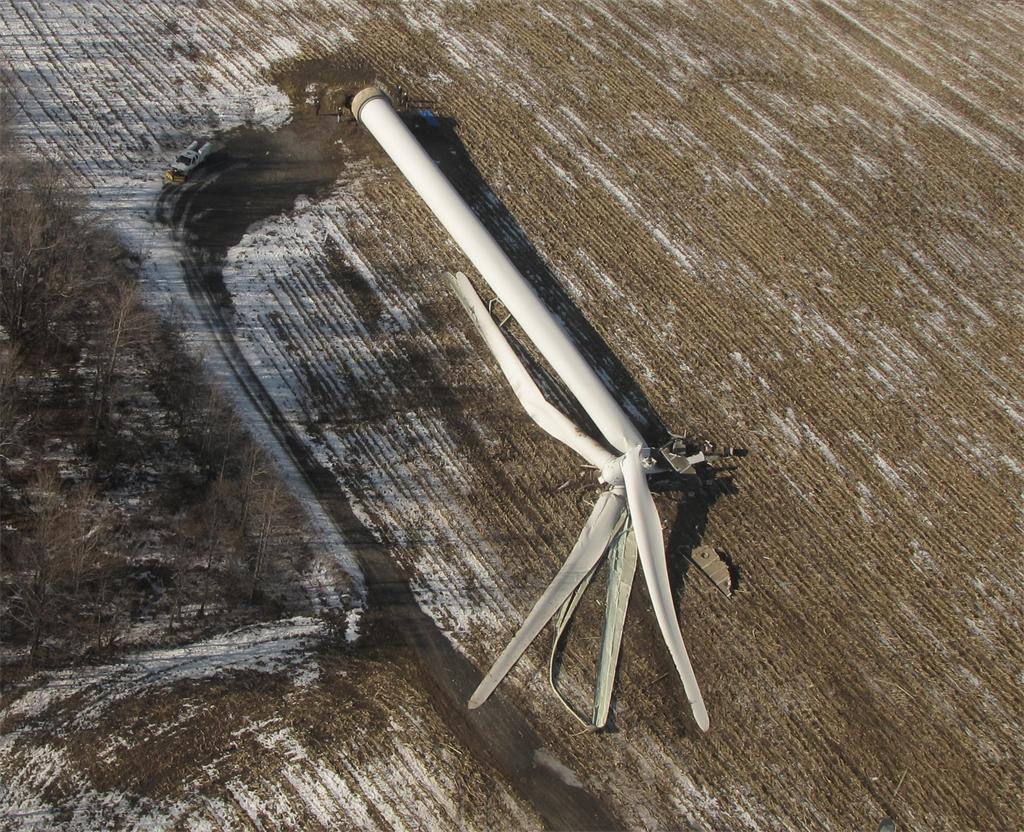
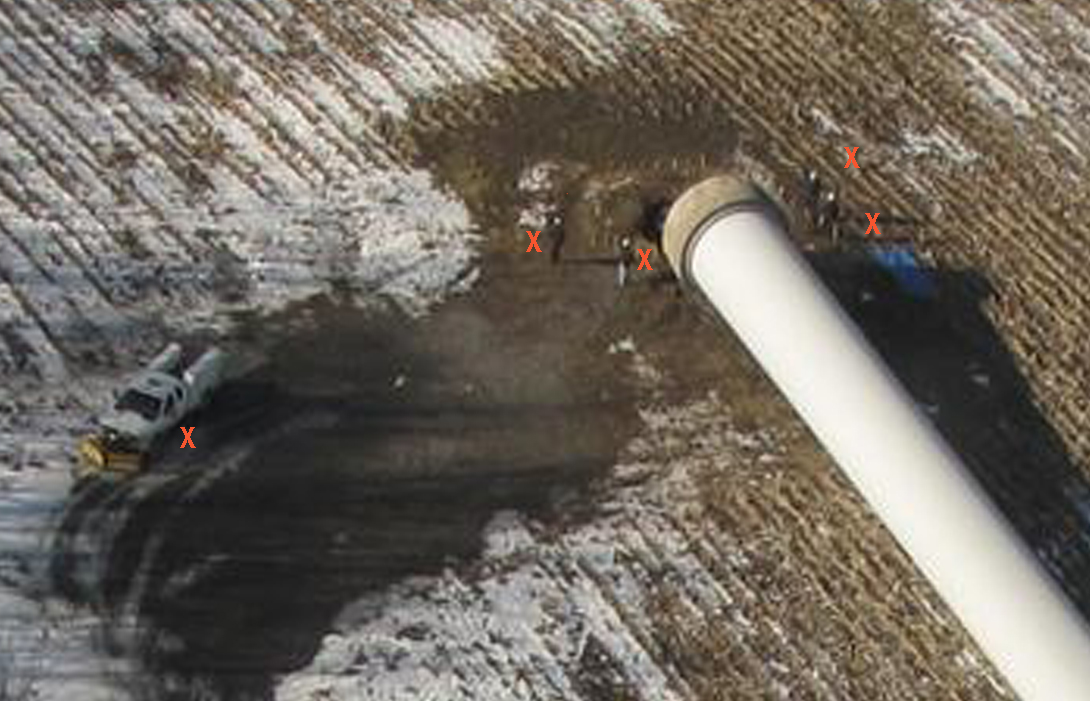
Fenner, Madison County (WSYR-TV) – A turbine at the Fenner wind farm has toppled, and engineers are on the scene trying to figure out how it happened.
The tower, which is more than 300 feet long from the base to the tip of the blade, is located just off Buyea Road, and is one of 20 generating electricity.
"I was turning over in bed and it sounded like a big clap of thunder" said Jill Van Allen, who lives across the street. "I was waiting to see the lightning through my bedroom window (but didn't)".
Fenner Town Supervisor Russ Cary was notified by company officials at Enel North America, which owns the farm. He tells us Enel did not have any answers as to how it happened, but adds, the towers were built a distance away from homes for this very reason-that if they collapse, they won't do any harm.
From another news story:
Officials investigating why 187 ton windmill collapsed in Fenner
QUOTE: "Bob Stinson, a resident of South Road nearly two miles from Turbine 18, said it sounded like "a sonic boom" when the windmill toppled.
"I felt it. It shook the house. It woke me up," Stinson said."
READ ENTIRE STORY BY CLICKING HERE
